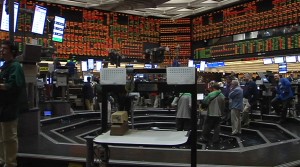CHICAGO — The Chicago Board of Trade is a place where hand signals are thrown wildly, orders are shouted, papers and coffee cups are scattered across the floor — and where daily settlement prices are established for the agricultural futures markets.
This may change soon, as the CME Group Inc., the operator of the world’s largest futures market, moved Monday to implement a plan to change its price discovery mechanism.

The open-outcry system of trading has taken place at the Chicago Board of Trade for more than 150 years.
A group of traders, though, has sued CME Group in Illinois state court in Chicago. The complaint filed Friday aims to block a shift to a “blended settlement,” which includes both open-outcry and electronic trading information in settling prices. Currently agricultural futures are settled via open outcry, even though most of the volume is electronic.
Heather Koch, director of ProtectAG Futures Inc., an organization that protests the change, said Monday that the case will be moved to federal court, with a hearing set for Tuesday morning.
Traders claim the new system would decrease trades and result in job losses at the CBOT. The number of floor traders would likely drop if the CBOT moves to a process that downgrades the role of floor trades in determining settlement price.
Both sides are expected to be in court Monday, with the plaintiffs seeking relief — in the form of an injunction barring CME from going through with the plan — and the court considering the traders’ case. There is no indication when a decision could be made.
Chris Grams, a CME Group spokesman, declined to comment on any pending litigation.
The exchange was scheduled to transition to the new settlement procedures for both grains and livestock futures in March, and then in April.
The plan was met with vocal opposition from floor traders.
“Initially when electronic trading started, it gave all players access to the marketplace with a computer,” argued ProtectAG Futures Inc.’s Koch. “It wasn’t supposed to be this mathematical model determining food prices.”
Although purely electronic trading is prevalent in other asset classes and on other exchanges, some brokers believe electronic trading should be limited in agricultural futures because of the volatility it can create.
“Food markets, because of their purpose, should be more stable than not,” said Kelly King-Taylor, an independent broker at the Chicago Board of Trade. “That is why futures were created in the first place, to take the uncertainty and chaos out of food pricing for farmers and end-users. What is taking shape now is more akin to a virtual casino.”
Electronic trading, however, comprises far more of the activity at the Chicago Board of Trade than open outcry.
“We believe the new settlement methodology accurately captures contract value across both the open outcry and electronic trading venues during the settlement period and is fully consistent with our functions as a designated contract market and a derivatives clearing organization,” CME Group spokesman Grams said in an email interview.
Advocates, including farmers, believe the change to the settlement procedure should already be in place.
“The modified settlement process recently introduced by CME Group is a positive step for the industry and long overdue in our opinion,” according to a statement from CHS Inc., the nation’s largest farmer-owned cooperative, which is actively involved in grains and other agricultural commodities. “It’s the only fair and logical way to establish settlements prices for agricultural futures moving forward given that 90%-95% of each day’s volume is traded electronically.”
In May, the CME extended its trading hours from 17 hours per day to 21 hours — close to the same time IntercontinentalExchange Inc., or ICE, announced it would offer agricultural futures products. ICE, a fully electronic exchange based in Atlanta, is open to investors 24 hours per day.
Traders have trouble competing with super-fast computer programs, sometimes referred to as high-frequency trading.
“Bottom line is if we move to a volume-weighted average to discover price, which we are, these traders won’t last very long,” said Dezso Szalay, a commercial grain trader based in Chicago. “Many of us have been anticipating this so-called ‘end of days’ and some feel it’s only a couple of weeks before this floor starts to empty.”

